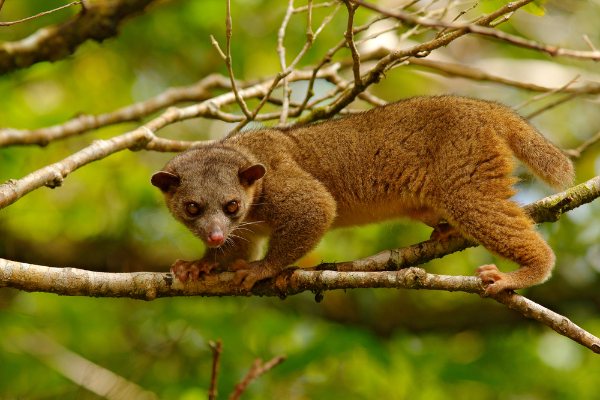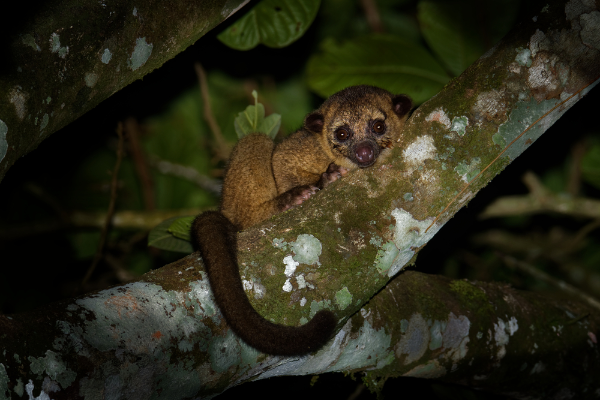The kinkajou is a strange and exotic animal found in the rain forests of Central and South America. They are night-loving creatures that are known for their curious nature and playful demeanor. Kinkajous make great pets for those who are looking for an unusual companion animal. Though they can be difficult to care for, they are rewarding animals to own. If you’re interested in learning more about these fascinating creatures, keep reading!

Kinkajou Description
The Kinkajou is a small mammal of the rainforest canopy, related to raccoons, coatis and olingos. It has a body length of 60-80cm, a tail length of 60-100cm and weighs 2-5kg. The Kinkajou has thick fur which is brown or reddish in color, and black markings on its face. It has a long, prehensile tail which it uses for climbing. Kinkajous are nocturnal animals which live in small family groups consisting of a male, several females and their young. They eat fruit, leaves, insects and small animals. Kinkajous are found in the rainforests of Central and South America. Kinkajous are sometimes kept as pets, but can be aggressive if not handled properly.
Kinkajou Habitat
Kinkajous are found in the tropical forests of Central and South America. They are most commonly found in rainforests, but can also inhabit dry deciduous forests and secondary forests. Kinkajous are arboreal animals, meaning they spend most of their time in trees. They are proficient climbers and often build nests in the branches of trees. Kinkajous are nocturnal animals, feeding on fruit, flowers, leaves, and insects at night. Kinkajous play an important role in their ecosystem by dispersing seeds through their feces. Kinkajous are hunted for their fur and for the pet trade, and are also threatened by habitat loss due to deforestation. Kinkajous are protected under Appendix II of the Convention on International Trade in Endangered Species of Wild Fauna and Flora (CITES). Kinkajous can only be found in the wild; they cannot be successfully bred in captivity.
Kinkajou Diet
Kinkajous are arboreal mammals that are native to the tropical forests of Central and South America. Kinkajous are nocturnal animals and primarily live alone or in pairs. Kinkajous have a prehensile tail that they use to assist them in climbing trees. Kinkajous are omnivorous animals and their diet consists of fruit, flowers, leaves, insects, and small vertebrates. Kinkajous play an important role in the dispersal of seeds throughout the tropical forest. Kinkajous often eat fruits that are too large for them to digest and as a result, these undigested seeds are deposited in new areas where they can germinate and grow into new plants. Kinkajous play an important role in maintaining the health of the tropical forest ecosystem.
Kinkajou Size
Kinkajous are small mammals that belong to the family Procyonidae. They are typically between 17 and 24 inches in length, with a tail that is about the same length as their body. Kinkajous weigh between 2 and 5 pounds. Kinkajous have thick fur that is brown or reddish in color, and they have a long, prehensile tail. Kinkajous are native to Central and South America, and they inhabit tropical forests. Kinkajous are nocturnal animals, and they feed on fruits, flowers, and insects. Kinkajous are not considered to be endangered, but their populations are declining due to habitat loss and hunting. Kinkajous are also sometimes kept as pets, which can result in them being taken from the wild.

Kinkajou Lifespan
Kinkajous are a type of mammal that is native to Central and South America. They are closely related to raccoons and coatis, and are often mistaken for these animals. Kinkajous typically have brown or reddish fur, and a long tail that is used for balance. They are proficient climbers, and spend most of their time in trees. Kinkajous are nocturnal animals, and sleep during the day. Kinkajous typically live for 20-25 years in the wild, but can live up to 30 years in captivity. Kinkajous are uncommon in the pet trade, but those that are kept as pets require a large amount of space and specialized care. Kinkajous are not recommended as pets for most people.
Kinkajou Behavior
Kinkajous are arboreal animals, meaning they live in trees. They are native to the tropical rainforests of Central and South America, where they are most commonly found in the canopy layer. Kinkajous are nocturnal animals, and during the day they sleep in tree hollows or nests made of leaves. Kinkajous are solitary animals, and only come together to mate. Females give birth to one to three offspring at a time, and Kinkajou young stay with their mother for up to two years. Kinkajous are omnivorous animals, and their diet consists of fruits, flowers, nectar, insects, small mammals, and eggs. Kinkajous have a prehensile tail which they use to grasp branches as they move through the trees. Kinkajous are proficient climbers and can even climb down trees headfirst. Kinkajous typically live for 20-30 years in the wild.
Kinkajou Speed
Kinkajous are small, arboreal mammals native to the tropical forests of Central and South America. Kinkajous are proficient climbers, and they are known for their sleek, agile bodies and long tails. Kinkajous are also notable for their speed; they are able to reach speeds of up to 35 miles per hour when running through the trees. Kinkajous are nocturnal animals, and they spend most of their time in the canopy of the forest. Kinkajous are fruit eaters, and they play an important role in dispersing seeds through the forest. Kinkajous are gentle creatures, but they can be aggressive if they feel threatened. Kinkajous are hunted by humans for their fur, and they are also captured and sold as exotic pets. Kinkajous are fascinating animals, and they play an important role in the ecosystem of the rainforest.
Kinkajou Hunting
Kinkajou hunting is a popular activity in many parts of the world. Kinkajous are small, nocturnal animals that are native to Central and South America. Kinkajous are often hunted for their fur, which is used to make clothing and other items. Kinkajous are also hunted for food, as their meat is considered a delicacy in many cultures. Kinkajou hunting can be done with guns, dogs, or even by hand. Kinkajous are typically shy animals, so hunters must be patient and stealthy in order to succeed. Kinkajou hunting can be dangerous, as the animals are known to defend themselves vigorously when cornered. For this reason, it is important for hunters to be properly trained and equipped before embarking on a kinkajou hunt.
Conclusion
The kinkajou is a creature that fascinates many people. Its unique features and adorable personality make it a favorite among those who have had the chance to meet one in person. While these animals may seem tame, they are actually quite wild and require a great deal of care and attention. If you are thinking of adding a kinkajou to your family, do your research first and be sure you are prepared for the challenge of owning this exotic pet.
Frequently Asked Question

